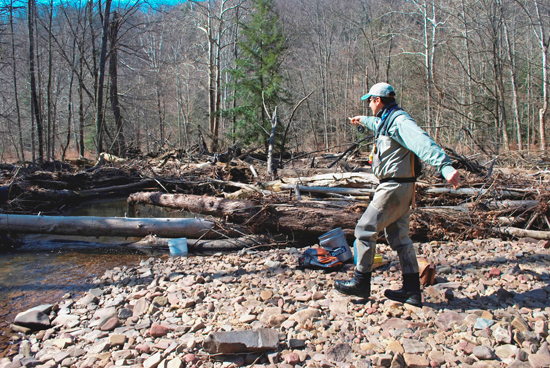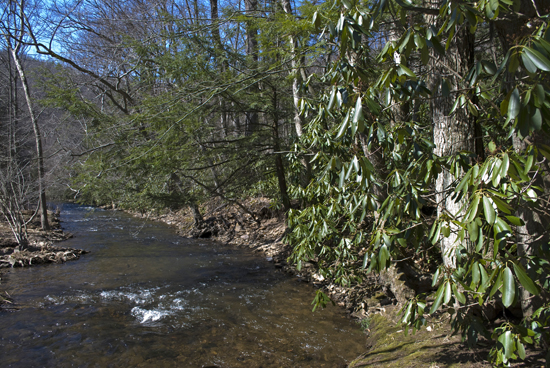Tagged brook trout reveal pristine health of Md.’s Savage River
Scientists use brook trout as an indicator of the health of the Chesapeake's local streams and rivers
“The smallest ripples are often the largest fish,” Matt Sell tells me as he waves his fishing line back and forth over a dimple in the water. The scene may seem appropriate for a Saturday afternoon, but it’s actually a Wednesday morning, and Matt is at work as a brook trout specialist for the Maryland Department of Natural Resources’ (DNR) Inland Fisheries Division.
Clad in chest waders and a t-shirt, Matt is armed with a fishing pole and the instincts of someone who’s been angling most of his life. His fishing efforts are rewarded with a six-inch brook trout—exactly the species he was looking to catch.

In most parts of the state, a brook trout would be a rare catch. More than 55 percent of Maryland’s sub-watersheds have lost their entire brook trout population, and only two percent of the state’s sub-watersheds have a healthy population.
Why the sudden and steep population decline? Brook trout have very specific habitat requirements that are threatened by development, urbanization and poor land management.
“Brook trout need cold, very clean water with no sediment,” explains Alan Heft, biologist with Maryland DNR’s Inland Fisheries Division. “They need specific sizes of gravel in certain areas of the stream to reproduce. If they don’t have these conditions, they can’t exist.”
When excess sediment erodes from stream banks and construction sites, dirt gets into the gravel beds where brook trout spawn, hardening the bottom into a concrete-like material. And when water temperatures rise above 68 degrees due to factors such as hot summers and lack of a tree canopy along the edge of a stream, a brook trout’s internal system shuts down.
“Brook trout are kind of like the canary in the coal mine,” Alan says. “When you have a large brook trout population, you know that you have good water, clean water and a protected watershed. When you lose the brook trout, you know that you have problems.”
Because brook trout have such steep habitat requirements, they are used as an indicator species: their presence indicates whether or not a watershed is healthy. By closely monitoring brook trout populations, scientists can learn not just about the fish, but about water quality in a river system.
But monitoring brook trout requires more than just fishing. Although there are many methods used to monitor the fish, Matt and Alan have chosen radio tags, which they insert into each fish’s skin through a quick, painless surgery. The radio tags allow Matt, Alan and other scientists to follow the movements of brook trout for the next year or so.
Brook trout and the Savage River watershed
When I follow Matt and Alan on their Wednesday morning fishing excursion, they bring me to a dense forest of eastern hemlocks. Mountain laurels hug the shallow stream banks, blocking the sun and forming a blanket of shade over the river. With the lush layers of forest, the serenity of fishing and the absence of human influence, it feels as though we’ve traveled back in time. But we’re actually on western Maryland’s Savage River, a 30-mile-long tributary of the Potomac River and the largest remaining native brook trout habitat in the mid-Atlantic.

Although brook trout have been eliminated from the majority of Maryland’s waterways, these fish have remained in the Savage River for a few reasons. With just 1,500 residents, the Savage River watershed has not been subjected to the fast-paced development taking place in other parts of the Chesapeake Bay region. About 80 percent of the watershed is state-owned, meaning that the vast majority of the land around the river is safeguarded from development and managed to enhance water quality and brook trout habitat. (Plus, who wouldn’t want to live in a traffic-free, forested oasis in the Appalachian mountains?)
“Typically with brook trout habitat in the east, outside of Maine and a few places in New York, all of the tributaries are disconnected. There’s damage or dams or pollution, and they can’t go from one spot to another,” Alan explains. “But these fish can go up to 30 miles in one direction. They can go up Poplar Lick six miles; they can go down to the reservoir. It’s incredibly unique and there’s hardly anything like this left. It’s our gem.”
Sure, there’s plenty of room for the fish to travel, but Alan, Matt and others with the Eastern Brook Trout Venture want to know exactly where the Savage River’s brook trout swim throughout the seasons. “In order to answer our questions, we implemented this radio tagging study last year,” Matt tells me. “Last year, we had one fish move about three miles overnight. I had one fish that moved about four miles from where it was tagged.”
These sudden movements tell Matt and Alan that some factor encouraged the fish to move far—and fast. “It seems the impetus for these fish to leave the river in the summer months was an increase in water temperature,” Matt says. “In the winter months, they move back.”
By identifying the fish’s preferred habitats, biologists will be able to manage the land to imitate these favored spots, which will help keep the river’s brook trout population healthy.
The rules
The large-scale decline of brook trout is not due to overfishing. However, harvesting these fish certainly won’t help rebuild populations. That’s why Maryland DNR decided to create a special regulation for brook trout harvesting in sections of the Savage River watershed.
“You can fish for brook trout with an artificial lure only, and you can’t keep them,” Alan says. “The result so far has been phenomenal, for both the population and for the quality of the fishing.”

(Image courtesy Jon David Nelson/Flickr)
Brook trout and the Chesapeake Bay
It may be difficult to understand how Matt and Alan’s brook trout restoration efforts in the Savage River—200 miles from the shores of the Chesapeake Bay—are connected to the Bay’s health. After all, western Maryland is a far cry from the crabs, oysters and sailboats associated with the nation’s largest estuary.
“Water rolls downhill,” Matt says simply. “It has since the beginning of time and it will continue to do so. If we can protect the water quality here, as it continues to move downstream, it has a better chance as it flows on towards the bay.”
So the restoration efforts Matt, Alan and other brook trout scientists dedicate their careers to aren’t so far removed from the Chesapeake after all. “These streams out here 200 miles from the Bay are vital,” Alan says. “When you add up all the water in these small headwater streams, it’s an amazing amount of water.”


Comments
What great reading and a wonderful article..
Thank you!
Your comment has been received. Before it can be published, the comment will be reviewed by our team to ensure it adheres with our rules of engagement.
Back to recent stories